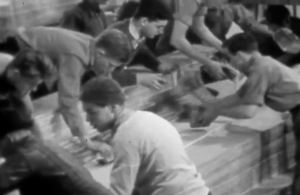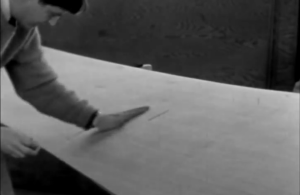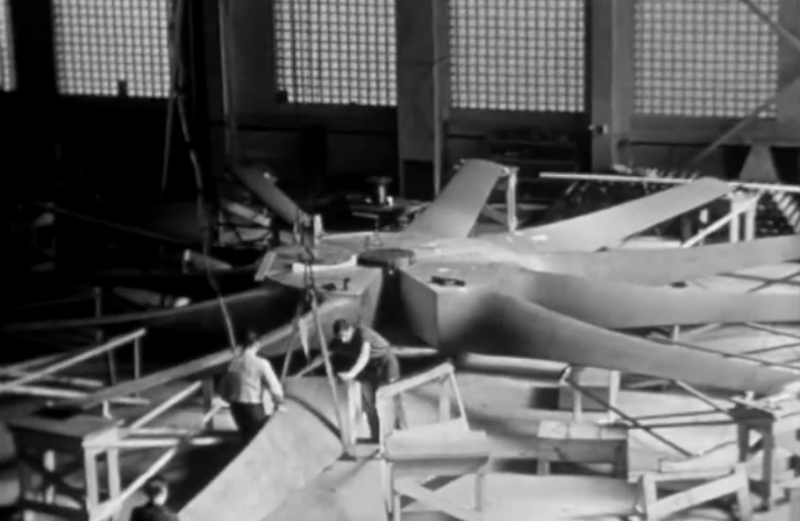During World War I, the United States felt they were lagging behind Europe in terms of airplane technology. Not to be outdone, Congress created the National Advisory Committee for Aeronautics [NACA]. They needed to have some very large propellers built for wind tunnel testing. Well, they had no bids, so they set up shop and trained men to build the propellers themselves in a fantastic display of coordination and teamwork. This week’s film is a silent journey into [NACA]’s all-human assembly line process for creating these propellers.
Each blade starts with edge-grained Sitka spruce boards that are carefully planed to some top-secret exact thickness. Several boards are glued together on their long edges and dried to about 7% moisture content in the span of five or so days. Once dry, the propeller contours are penciled on from a template and cut out with a band saw.
 After about 35 of these laminations have been made, they are stacked and dry-fit against wax covered filler blocks. These blocks are necessary to maintain constant and even pressure throughout the giant press. Next, the laminations are stacked upside down near the press and marked for glue application. Here’s where the process gets really intense: these men have just 15 minutes starting from the time the first bit of glue is applied to get all the laminations covered, stacked, and packed in with filler blocks.
After about 35 of these laminations have been made, they are stacked and dry-fit against wax covered filler blocks. These blocks are necessary to maintain constant and even pressure throughout the giant press. Next, the laminations are stacked upside down near the press and marked for glue application. Here’s where the process gets really intense: these men have just 15 minutes starting from the time the first bit of glue is applied to get all the laminations covered, stacked, and packed in with filler blocks.

This spruce and glue Dagwood sandwich spends 24 hours under pressure. When the time is up, the filler boards are pried away from the propeller, and the excess glue is scraped away. Next, the corners are roughed off with a rotary sander.
To achieve the aerodynamic ideal, the prop is fitted with ribs every six inches or so down its length, and the thicknesses along it are checked to within 1/100th of an inch. A pair of men pass a saw along the edge of each rib to notch it just so, and then the excess wood is removed with pneumatic planes designed and developed by [NACA] to constantly blow shavings all over the place. Finally, the blade whisperer is called in to check the fairness and make nitpicky markings wherever the wood is high by a thousandth of a hair.
Now the blade is ready to join its brethren in the 10-ton hub. Once all the blades have been hoisted into place, the top surface is machined and the upper hub plate is fitted and bored out. After all of that work, the blades come right back out so that holes can be drilled through them to accommodate the steel sleeves and bars that hold it all together.
http://www.youtube.com/watch?v=l9UbnJlhrHA
Part two:
http://www.youtube.com/watch?v=OR3e8waXuWk
Part three:
http://www.youtube.com/watch?v=WS-XqOsxBHY
[Thank you to David for sending this in]
Retrotechtacular is a weekly column featuring hacks, technology, and kitsch from ages of yore. Help keep it fresh by sending in your ideas for future installments.















Imagine going through all that then cutting in the wrong place or sanding it just a little too much -_-
Ehh, just use some wood filler and call it good ;)
Very nice! And no CNC involved :-D
One question:
“Filler blocks are […] accurately alined…”
Is that a spelling mistake or was it the proper way to write “aligned” back then? Or can you still spell it like that?
‘Alined’ is still an accepted, alternate spelling. Did you notice ‘templet’ as well?
Wonder if they used Gorilla Glue?
No, these blades are still around.
don’t laminate wood with gorilla glue people
Obviously a stupid question from someone who knows nothing about woodworking: What’s wrong with gorilla glue?
Gorilla glue expands, which is something you don’t want when you’re trying to laminate and smash wood together as close as possible. It’s more of a foam, which is really weird. It expands to fill the gaps, but that’s a terrible idea.
If you’re gluing wood, just get some titebond. For really old stuff, get some hide glue or gelatin. There is a place for gorilla glue, but it’s pretty much only used with exotics (oily) or stuff that will be used outdoors.
Titebond II (or III) is still more than sufficient for outdoor or underwater use. Putting that another way, I don’t know if there is any type of wood that would outlast a Titebond II glue bond where wet or even underwater conditions exist.
Dump the Gorilla Glue and try epoxy instead. Epoxy is cheaper, has more uses, and has many more years of shelf life.
You get fur bits in your joints.
That too.
If I remember my FAR’S correctly, Casein glue is the only one that is acceptable for wood splices on aircraft or components. Been almost 50 years since I did my spar splice so things could have changed but It’s good stuff, mix what you need and work fast.
Couldn’t they just glue 10 square boards together an then band saw them?
Did you bother to watch all three videos, it explains pretty well why they didn’t just waste a ton of lumber.
Thats exactly how I would do it, 80% glue and somehow sanding and cutting it into the right shape :p
Cool videos. Apparently 1941 was way before OSHA was around. I wonder how many of those workers were crippled for life by stupid accidents or bad operational procedures.
An interesting note is that the guys doing this work are model makers, that is they were really hired to make the models that will be placed inside the wind tunnel to be tested. There’s quite a screed about this in James Michenor’s novel Space, as this wind tunnel contributed to some major aeronautical advances and a poorly made model could come apart sending pieces slamming into that precious turbine.
this is way cool, but see if you can find some video of how F4-U propellers were made!
they took a solid rod of aluminium, bored it out, rolled it flat, then silver soldered the edges!
At the time they were THE most high tech air screws ever made
https://www.youtube.com/watch?v=FJn2xQJ_f1g
Fascinating
Remember when the gov could do things like this? I don’t. To young. But damn could they get shit done. Now compare to every enempt agency today that swears its just about to fix all of its problems and be the best. Sometimes I think the best future the us and its gov can hope for is the slowest possible slide into oblivion
I’m impressed by how skilled the workers seem to be. No rush, go slow and careful. Lots of safety problems, though…no safety glasses anywhere and one guy was wearing what appeared to be a chain bracelet.
The government can still get a lot done, it’s just that we can’t agree on what we want it to do. Our population is about three times larger and a lot more diverse since this was made, and some us want low taxes and minimal federal government, others want high taxes and single payer healthcare, others want us to bomb everyone who looks at us funny, and so on. The result is we do all of those things halfway, which means we do none well. Personally I think we work benefit from more federalism but right now too many people are convinced their side/party can win the war once and for all so they’re still playing for total victory.
Tossing around large clamps is probably a no-no today!
videos taken down?
“Watch this video on Youtube. Playback on other sites has been disabled by video owner.”
Notice how most of the model makers looked between 13-20. Back when skills were in reality as apposed to virtual.
People should have to know how to do this without all the fancy tools. Imagine where we’d be if an EMP took out the planet….
People would know how to do this stuff, but it would take about 10 generations of figuring the stuff out again.
We can just watch the video after the EMP